An excellent hybrid for open ground - the Shady Lady f1 tomato: we grow unpretentious tomatoes without hassle
Shady Lady f1 tomatoes are an early-ripening hybrid for open ground. It is characterized by high productivity if the rules for forming bushes are observed. The fruits have a pleasant taste without sourness and can withstand transportation over long distances.
In this article we will tell you why the hybrid has been highly praised by farmers and how to grow it to get better results.
Description of the hybrid
Shedy Lady f1 - a hybrid from the Dutch seed company Nunhems. Included in the State Register of the Russian Federation in 2005. Bred for cultivation in garden plots, household plots and small farms in open ground. The plant is determinate and bears fruit early. Decorative bushes, leafy, with a strong root system.
In the photo - Shady Lady tomatoes f1.

Distinctive features
The table shows the characteristics of the tomato:
| Indicators | Characteristic |
| Weight | 160–200 g |
| Form | Round |
| Coloring | Red |
| Leaves | Large, rich green color |
| Type of inflorescences | Simple |
| peduncle | Without articulation |
| Number of slots | Four or more |
| Pulp | Juicy but not watery |
| Taste | Sweet, pleasant |
| Skin | Dense, smooth, does not crack |
| Purpose | Salad tomatoes |
| Bush height | 60–70 cm |
| Ripening period | 105–115 days from sowing |
| Productivity | 7.5 kg/m² |
| Sustainability | To verticillium, fusarium, cladosporiosis, tobacco mosaic virus. |
| Transportability | High |
Growing seedlings
Work with seed material begins in early March, 55–60 days before the planned transfer of seedlings to the garden.
Preparing the soil and sowing seeds
Hybrid seeds are not soaked in antibacterial solutions, since they have already been processed before packaging. To speed up germination, the material is soaked for 12 hours in growth stimulating agents: “Kornevine”, “Novosile”, “Eco-gel”.
Seeds are planted in a light substrate consisting from turf, garden soil and rotted humus in a ratio of 1:1:1. The soil is pre-disinfected in the oven, microwave or filled with a solution of potassium permanganate.
A layer of soil is poured into a container 5–7 cm high, make furrows of 1–1.5 cm, lay out the seeds at a distance of 2 cm and water with warm water. Stretch the film over the top and place it in a dark, warm place. Treated seeds will hatch faster at a temperature of +23 °C.
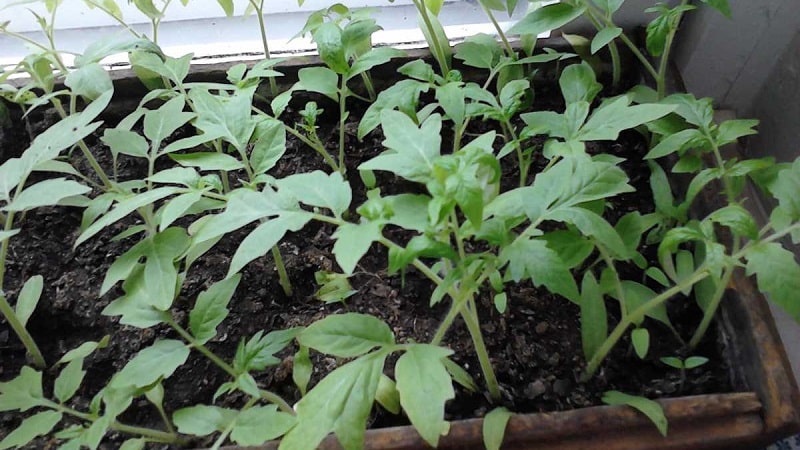
Seedling care
After the sprouts appear, the film is removed and take the seedlings out to a sunny windowsill on the south side or place them under a phytolamp. It is important to organize long daylight hours to prevent the seedlings from stretching out into growth.
Picking into individual cups is carried out after the appearance of 2 true leaves. Plants are fertilized once before planting in the ground with mineral preparations (Azofoskaya, Krepysh, Agricola, Kemira Combi), according to the instructions on the package.
Water after the top layer of soil has completely dried.
10 days before planting in open ground seedlings are accustomed to fresh air. To do this, the cups are taken out onto the balcony. For the first time, 15 minutes is enough. Every day the time is increased by 5–10 minutes.
Tomato cultivation
Planting in the garden begins at the end of May. By this time, the threat of frost will have disappeared, and the soil will have warmed up thoroughly.
Landing
The best place for tomatoes is considered to be the land in which they were previously grown. carrots, beets, cabbage, onions, beans or spinach. In autumn, the soil is dug up and fertilized with bird droppings, ash, compost or humus at a rate of 5 kg per 1 m². The best mineral fertilizers are potassium salt (20–25 g per 1 m²) and superphosphate (40–50 g per 1 m²).
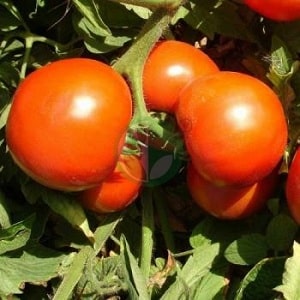 In the first ten days of May, the soil is dug up again and fertilizing mixed in equal parts is applied to a depth of 15 cm: 1.5 kg of wood ash, 25 g of ammonium sulfate and 1 kg of bird droppings per 1 m².
In the first ten days of May, the soil is dug up again and fertilizing mixed in equal parts is applied to a depth of 15 cm: 1.5 kg of wood ash, 25 g of ammonium sulfate and 1 kg of bird droppings per 1 m².
Holes for seedlings are dug at a depth of 15 cm, spilled with a hot solution of potassium permanganate. The soil in the containers is moistened abundantly so that the seedlings can be removed without any problems. The lower leaves are torn off and, together with the earthen lump, transferred into the hole.
6-7 seedlings are planted per 1 m² at a distance of 70 cm and watered with warm, settled water.
The soil is mulched with straw or sawdust in a layer of 10 cm. The plantings are covered with film and left to take root in the new location for 8–10 days. A hole is made in the film to prevent the risk of late blight infection in the created greenhouse conditions.
About other varieties of tomatoes:
We’ll tell you and show you how to grow the “Explosion” tomato
“Little Red Riding Hood” tomatoes, popular among summer residents
Care
Tomato care is standard and includes weeding, weed removal, watering, loosening, fertilizing.
10 days after planting, the plants are watered at the root with warm water. Do this once a week, in the evening. With the onset of heat, the soil is moistened every 2-3 times every 7 days.
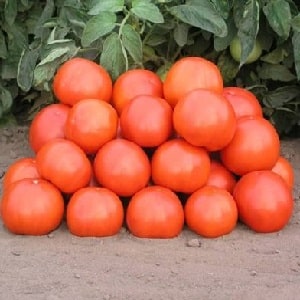 Hilling is carried out as the bushes grow to strengthen the rhizome.
Hilling is carried out as the bushes grow to strengthen the rhizome.
Tomatoes are fertilized once every 10 days according to the following scheme::
- 2 weeks after planting - 1 part mullein per 10 liters of water.
- Subsequent fertilizing is potassium-phosphorus - 60 g of nitrophoska per 10 liters of water.
Before flowering, the consumption per bush is 1 liter, after - 2–5 liters.
Forming bushes into 2 stems significantly increases productivity. The stepsons are carefully broken out or cut off with a sharp knife.
Important! 10 days after planting, the bushes are tied to low stakes to prevent the stems from breaking under the weight of the tomatoes.
Prevention of diseases and pests
Tomatoes Shedy Lady are resistant to nightshade diseases: verticillium, fusarium, cladosporiosis, tobacco mosaic virus (TMV).
For the prevention of late blight (brown spots on leaves, stems and fruits) bushes are regularly irrigated:
- fungicides: “Previkur”, “Fitosporin”, “Quadris”, “Topaz”, “Chorus”, “HOM”, as well as Bordeaux mixture, copper sulfate, according to the instructions;
- infusion of garlic with potassium permanganate (100 g of chopped garlic cloves, pour 250 ml of water, leave for 24 hours, bring the volume to 10 l and add 1 g of potassium permanganate);
- yeast solution (dilute 80 g of pressed yeast in 10 liters of water);
- a solution of milk with iodine (add 1 liter of low-fat milk and 20 drops of iodine to 10 liters of water);
- whey diluted with water in a 1:1 ratio.
Bushes are treated with folk remedies before flowering begins., then every 10–14 days. The use of chemicals is stopped 2 weeks before the start of harvest.
Preventive measures will help prevent infection:
- mulching beds with peat, sawdust, pine needles;
- spring disinfection of soil with copper sulfate (100 g of dry matter per 10 liters of water);
- compliance with the irrigation regime in order to prevent excess moisture in the soil;
- timely application of potassium-phosphorus fertilizers.
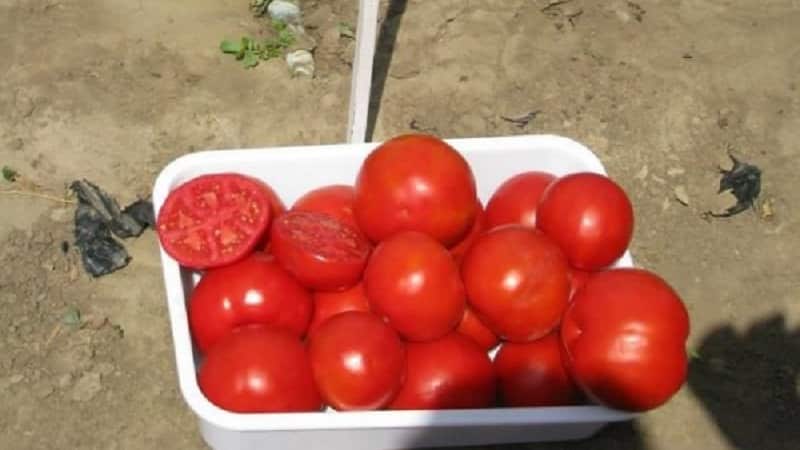
Cope with aphids whitefly, spider mites will help:
- modern insecticides: “Commander”, “Iskra”, “Intavir”;
- biological products: “Fitoverm”, “Biotlin”, “Strela”.
Among folk remedies, the most effective are considered:
- Garlic infusion. To prepare it, add 400 g of finely chopped garlic arrows to 1 liter of warm water and leave for 4-5 days. The bushes are treated 3 times during the entire growing season, every 3 days.
- Ash. Add 50 g of ash to 10 liters of water, stir and filter through cheesecloth. Then pour in 50 ml of liquid soap. Apply the solution to spray the bushes on an ongoing basis every 14 days.
- Infusion of tobacco. Add 200 g of shag to 5 liters of warm water and leave for 48 hours. The plants are treated with the liquid 3-4 times with an interval of 3 days.
Sown between the beds marigolds, calendula, leaf mustard, fragrant dill to attract ladybugs that prey on aphids.
Features of growing in greenhouses
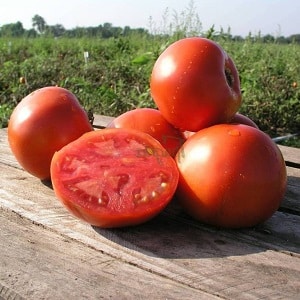 Some gardeners are of the opinion that it is irrational to take up space in a greenhouse with spreading determinate bushes: the Shedi Lady hybrid is intended for growing primarily in open ground. Nevertheless, the culture feels great in greenhouse conditions.
Some gardeners are of the opinion that it is irrational to take up space in a greenhouse with spreading determinate bushes: the Shedi Lady hybrid is intended for growing primarily in open ground. Nevertheless, the culture feels great in greenhouse conditions.
Planting of seedlings begins in early May. The soil is first loosened, holes 10–15 cm deep are dug, disinfected with a hot solution of potassium permanganate and 1 tbsp is added. l. ash in each of them. The bushes are watered with warm, settled water.
No more than 6 seedlings are planted per square meter. Caring for the crop is standard and includes regular watering, loosening the soil, pinching with staking of stems and applying the same fertilizers as when grown in open ground.
It is important to carefully monitor the condition of the bushes and at the slightest sign late blight start processing, because high humidity in a greenhouse is an ideal environment for the proliferation of late blight. When grown outdoors, the problem can often be avoided.
Prevent or minimize infestation in the greenhouse preventive measures will help:
- autumn treatment with sulfur bombs;
- removing the top layer of soil (5–10 cm);
- spring disinfection of soil with copper sulfate (100 g of substance per 10 l, consumption - 2 l/m²);
- mulching the beds with sawdust, pine needles, peat after planting;
- moderate watering.
Difficulties in growing crops indoors relate to pollination, since insects do not have unhindered access to flowers. To do this, hives with bees are placed in the greenhouse or a fan is installed. The bushes are periodically shaken or lightly tapped on the stems with a stick so that the pollen does not fall off. After this, the soil is moistened and the flowers are sprayed with water.
Harvest Application
Tomatoes begin to ripen 105–115 days after sowing. Harvest - from June to August. It is permissible to collect fruits at the stage of technical maturity and ripen them in a cool place. In cooking, vegetables are added to fresh vegetable salads, soups, and used to prepare juices, sauces, and purees.
Advantages and disadvantages
 Advantages of the Shedi Lady hybrid:
Advantages of the Shedi Lady hybrid:
- resistance to adverse weather conditions (heat, sudden temperature changes);
- immunity to nightshade viral diseases;
- possibility of transportation over long distances without loss of commercial qualities;
- dense skin, not prone to cracking;
- wonderful taste;
- possibility of ripening outside the bush;
- high yield.
The only disadvantages include the need for pinching and forming a bush with 2 stems to obtain large harvests.
Reviews
Reviews of Shady Lady tomatoes are mostly positive. Gardeners note the crop’s strong immunity to various viral diseases and ease of care:
Vera, Vyazma: “I am growing tomatoes in the open ground at the dacha. From time to time I try new varieties and hybrids. Last year I became interested in Shedy Lady f1. I read reviews online and got to work. The seeds were soaked in a growth stimulant, resulting in 100% germination. Strong seedlings were planted in separate peat cups. Planted in the last ten days of May. The bushes were fertilized abundantly with phosphorus and potassium and watered in moderation. There were no special problems with cultivation".

Stanislav, Kurchatov: “Shady Lady tomatoes are one of my favorites to grow in the garden. The culture is unpretentious in care, resistant to diseases and heat. The harvest is consistently high, the fruits are tasty and sweet".
Conclusion
Hybrid Shedi Lady for open ground has a strong immunity to viral diseases of nightshades (fusarium, verticillium, cladosporiosis, TMV), is distinguished by early and friendly ripening of fruits and the ability to ripen tomatoes collected at the stage of technical ripeness.
The culture withstands dry weather and sudden changes in air temperature. Pinching and forming bushes into two stems can significantly increase yield. It is permissible to grow tomatoes indoors, but yields do not decrease and disease resistance remains at the same level.